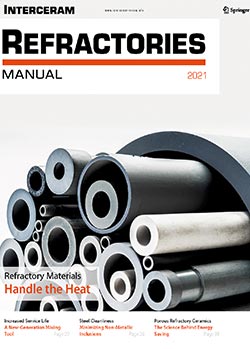 Refractories Manual - September 2021
Refractories Manual - September 2021
A new-generation Mixing tool
During the manufacture of refractory products, highly abrasive raw materials cause heavy wear on the mixing blades and tool holders. The mixing tool tunemixx for a vertical intensive mixer allows
wear parts to be changed quickly, production shutdown costs to be kept to a minimum and the service life of components to be extended significantly.
Dörentrup Feuerfestprodukte has been producing refractories for the foundry industry for over 100 years (Figure 1). Its portfolio includes refractory linings for coreless induction furnaces, channel and cupola furnaces, holding and pouring furnaces and receivers for processing iron, steel, heavy and light metals. For the manufacture of refractories, the company uses an inclined intensive mixer with a conventional rotor tool. Highly abrasive raw materials in the mix, such as corundum and zirconium oxide, lead to heavy wear on the mixing blades and tool holders. As a result, these components that come into contact with the product have to be replaced frequently and cause costly production shutdowns. Since the company changed to the Tunemixx TM320 mixing tool system from Krauskopf Maschinentechnik (Figure 2), its shutdown times have been reduced almost to zero and the service life of the wear parts has been increased considerably. The system was installed and successfully brought into operation in the summer of 2017.
Turning, repositioning and changing in a short time
Unlike conventional rotor systems, which have to be completely dismantled to remove the tools, the Tunemixx has a quick-change system in the centre of the mixing tool holder that holds the mixing blades in a radial position. This mechanical-hydraulic system is operated to open and close the lock and this allows the blades to be turned, repositioned or changed easily (Figure 3). Because of the heavy material load, the wear is greatest over the bottom third of the mixing tool. By turning the blades and moving them from the bottom to the top of the tool, it is possible to ensure that they wear evenly, reducing the amount of wear parts needed by up to 40 % per year. As a result, the diameter of the rotor remains almost unchanged, which helps to prevent the “upside-down Christmas tree” profile (Figure 4) and ensures a steady specific energy input to the mix. This is crucial to maintain the consistently high quality of the mixture.
Variable wear protection
The initial design of the wear protection system for the components that come into contact with the highly abrasive refractories consisted of carbide and aluminum oxide plates on the blades and aluminum oxide on the wear protection covering. As this did not meet Dörentrup’s expectations, the wear protection covering was given three coats of silicon carbide (SiC). Despite the high purchase cost, this solution received the approval of the customer and the components have been in use since 2018. To fulfill the customer’s requirements with regard to wear, Krauskopf also changed the wear protection on the mixing blades. The conventional single-sided blades that Dörentrup had previously used lasted for three months. After that, the components had to be completely replaced, since the rebuild was only worthwhile as a whole, but not for individual blades. As a result, the company had to buy and keep in stock a complete set of mixing blades. The wear protection on the new type of mixing blades was changed to a combination of a full carbide shell on the heavily loaded front end, carbide inserts on the long sides and a bonded silicon carbide layer over the whole surface (Figure 5). Together with the option of turning and repositioning the blades, this doubled their service life.
Now the mixing blades do not have to be completely replaced, but can be changed depending on their individual wear levels, which saves resources and improves the efficiency of the company’s stock system. The fact that Dörentrup no longer needs complex maintenance plans or time-consuming, labor-intensive shutdowns to replace the mixing blades has proved to be a major benefit for the company. The different variation and combination options for the design of the mixing blades also gives the manufacturer greater flexibility. The profile, cross-section, length and wear material can be adapted to the product being mixed and can be tested using the quick-change system.
Process engineering factors
The use of the new mixing tool system has also had a considerable influence on the process engineering parameters. For example, the
quality of the mixture and the mixing process, the increase in the throughput and the reduction of thermal input are good reasons for many machine operators to invest in the latest generation of mixing tools. Since the market launch of the new system, more than 40 units have been installed. These are used not only in the refractories industry, but also in the preparation of mold sand for foundries, in the glass sector, in the construction material and carbon industry and in metallurgy.
Conclusions
The new mixing system resulted in a reduction in the machine downtimes for changing the mixing blades from 2.5 and 7.5 man hours to 25 minutes and one man hour. This has led to a fall of 20 % in the production shutdown times and a resulting increase of 80 % in the contribution margin, together with an almost 90 % saving on the cost of maintenance staff. Another key benefit of the new system compared with conventional mixing tools is the axially symmetrical design of the mixing blades, which allows them to be used on both sides (they can be rotated through 180°) and reduces wear costs by almost 50 %.






